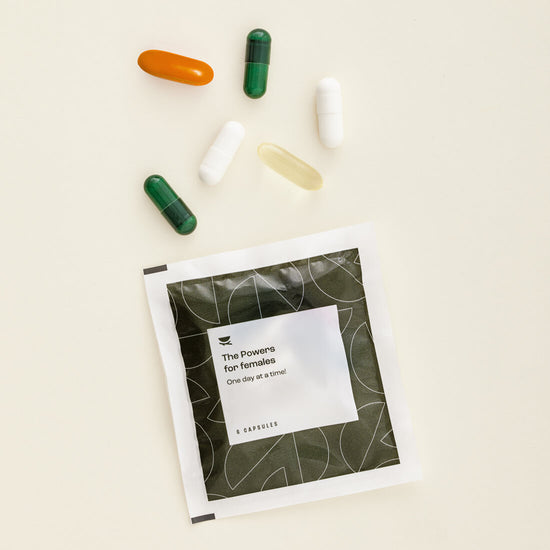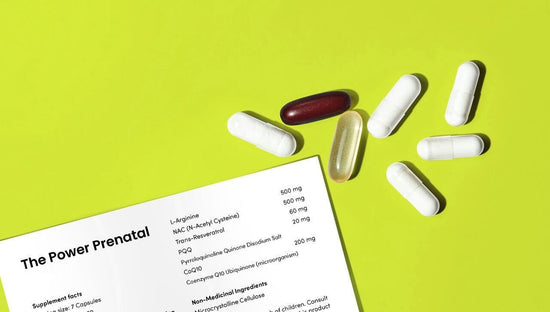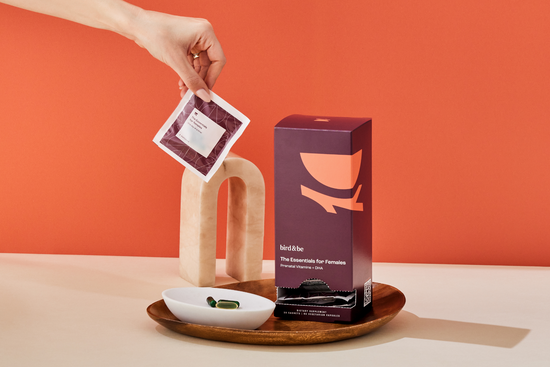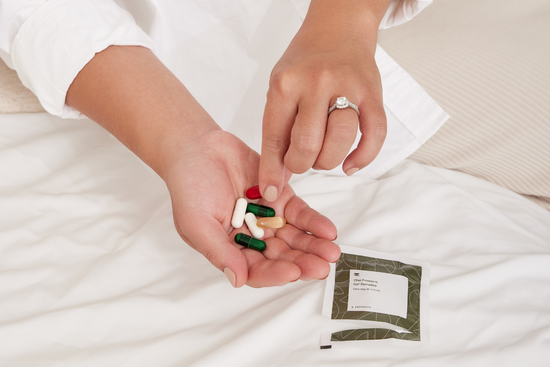If you’ve been told to start taking CoQ10 for your egg quality, you might be wondering which form is better: Ubiquinone or Ubiquinol. There’s been a lot of hype over Ubiquinol, but does it hold up? And what’s the actual difference between the two forms?
What’s the difference between Ubiquinone vs Ubiquinol?
CoQ10 is an antioxidant that’s called Ubiquinol in its reduced form (when it gains an electron) and Ubiquinone in its oxidized form (when it loses an electron). (Part of CoQ10’s role in energy production is helping to transfer electrons. It can keep switching back and forth depending what task it needs to get done.)
Although the body converts CoQ10 between these two forms, Ubiquinol is technically the active form used in your cells. This is one of the reasons Ubiquinol has been reported as the better supplemental form. On top of this, some researchers have said that Ubiquinol is more bioavailable (better absorbed) than its oxidized form, but it seems this claim was based on misguided reports (more on this in a sec!) and a previous lack in understanding of how CoQ10 is actually processed from the moment you take your supplement.
When you take a CoQ10 supplement, that capsule quickly dissolves in the stomach and releases the CoQ10 particles. When it reaches the small intestine, any Ubiquinol will be converted into Ubiquinone. These Ubiquinone particles get scooped up by fat-soluble bubbles (called micelles) that carry them to the intestinal wall border to be absorbed. From here, new cholesterol-associated bubbles (called chylomicrons) take over to shuttle that CoQ10 to the fluid of the lymphatic vessels where Ubiquinone gets reduced and converted (back) into Ubiquinol. So, the CoQ10 you ingested two hours ago, regardless of which form, will be in the Ubiquinol form by the time it reaches the bloodstream.
To recap, the CoQ10 in your stomach and small intestine will be almost 100 percent Ubiquinone, regardless of which supplement form you took! And about six to eight hours after you’ve taken your supplement, about 96 percent of the amount of CoQ10 in your blood will be in the Ubiquinol form.
Which CoQ10 form is more bioavailable?
The belief that taking Ubiquinol is better is based on old science and a previous lack of knowledge. If you rewind to over 10 years ago when the original bioavailability studies were done, CoQ10 supplement makers processed their products differently. At the time, unmodified Ubiquinone powder was packed into capsules, and it wasn’t very bioavailable. Since then, we’ve discovered ways to make Ubiquinone easier for the body to absorb. One method is called crystal dispersion, and another is fermentation. The latter is really popular today and produces something that’s identical to the form the body naturally makes. That’s great news for us now, but because these processes weren’t available at the time of the studies, many results aren’t relevant to the forms on the market today.
There are other factors to also keep in mind when it comes to the bioavailability and absorption of CoQ10. Those with intestinal inflammatory or immune disorders (like Celiac disease) and elderly individuals are at a higher risk of having compromised CoQ10 transformation and absorption. But even then, two large studies done in elderly patients have shown benefits from taking the newer, properly formulated Ubiquinone form of CoQ10.
In the two-year Q-SYMBIO trial, giving participants 300 mg of CoQ10 in the Ubiquinone form led to significantly fewer deaths from heart attack, heart failure and other cardiovascular events, compared to the placebo group. There were also improvements in heart failure severity and left-ventricular heart function. Blood CoQ10 levels were significantly higher after three months of supplementation with Ubiquinone, which shows that this form of CoQ10 can be effective.
The other trial was called KISEL-10 and it looked at 443 elderly people from Sweden. Starting in 2003, it was a randomized, double-blind, placebo-controlled study with a five-year followup. The trial used 200 mg of Ubiquinone daily and found that the group given the Ubiquinone had a significantly reduced cardiovascular mortality rate (5.9 percent vs 12.6 for those given the placebo).
In a different study that looked at 11 healthy individuals, the researchers found that the bioavailability of the two CoQ10 forms varied significantly in different people, regardless of which supplement they took. The participants were given three different CoQ10 formulas (along with capsules of Ubiquinone and Ubiquinol, the third type was a spray form of Ubiquinol) and their response to each was measured with a three-week break between each supplement. In the end, there were no significant differences in blood levels of CoQ10 with Ubiquinone versus Ubiquinol.
So where are the reports on Ubiquinol being better absorbed coming from? A 2009 study conducted on adults 60 years or older allowed subjects to continue taking any of their medications during the study, including statins which affect cholesterol (remember: cholesterol can transport CoQ10, so this introduces a variable that can affect the results). Subjects were on other medications too, including aspirin and those that treat heartburn, ulcers, high blood pressure and thyroid, which could all affect the absorption of nutrients.
Using complex calculations, this study found that blood levels of CoQ10 peaked faster when given Ubiquinol vs Ubiquinone (about 15.5 hours compared to 26.5 hours, respectively). These researchers claimed that Ubiquinol was therefore superior, but really all they showed was that in the short term, Ubiquinol reached a higher concentration and faster—about 11 hours faster on average. But along with the variability in other medications, there are two other things worth noting: this study used the old, unprocessed Ubiquinone, and not every individual in the study had that same reaction. In fact, the difference in each group was reported to vary by about 20 hours depending on the person.
Another study was conducted on 10 men over the age of 55 who were given each of the two forms of CoQ10 for two weeks. Unlike the above 2009 study, they specifically excluded patients who were taking medications known to affect the metabolism of fats and cholesterol (CoQ10 transporters). They found that six of the 10 subjects responded better to Ubiquinol, but two responded better to Ubiquinone (the other two didn’t have as strong of a response with either form). The researchers thus reported that supplementing with either CoQ10 form was effective in increasing blood levels.
In 2020, a similar trial found that regardless of what form was taken, supplementation led to CoQ10 appearing mostly as the Ubiquinol form in the blood. Standard Ubiquinone supplementation did have the lowest bioavailability of the three types of CoQ10 supplements, but they all increased the amount of CoQ10 in the blood to similar levels, with differences that were not statistically significant.
These studies suggest that Ubiquinol might be absorbed faster than Ubiquinone short-term in some individuals. But in the end, it doesn’t matter which one you take because your body converts it throughout absorption and transportation as needed.
Which CoQ10 form are fertility researchers studying for egg quality?
When it comes to getting pregnant, we also need to pay attention to which form of CoQ10 fertility studies are using, especially if they are showing benefits. Fertility and egg-quality studies have been using the Ubiquinone form of CoQ10. For example, a 2018 study in those undergoing IVF found that pre-treatment with Ubiquinone led to higher peak estrogen levels, lower requirements for gonadotropin medications, more eggs retrieved, higher fertilization rates and more high-quality embryos. Those given this CoQ10 were less likely to have their embryo transfers cancelled compared to those who didn’t take CoQ10.
A 2015 animal study using a model of ovarian aging (reproductively older female mice) injected Ubiquinone mixed with sesame oil under the skin. Those given CoQ10 had significantly improved ovulation rates. Researchers found it led to a greater number of ovarian follicles in the CoQ10-treated group, compared to the aged-matched controls. When these animals were allowed to breed, the reduced litter size found in older females was normalized in those given CoQ10.So, which CoQ10 form should I take for fertility?
Ubiquinol supplements are more expensive, can be very unstable, tend to have shorter expiry dates, and aren’t significantly superior to Ubiquinone. That’s why we use 200 mg of Ubiquinone in The Powers for females, and another 400 mg in the add-on Extra Egg Health Booster—we want to make sure you get an effective form that won’t degrade before you take it (and if that means we can offer it to you for a lower price than Ubiquinol, all the better!).
To max out the benefits, take your CoQ10 (no matter which form!) with a meal that has oil or fat in it (like olive oil, or the Omega-3 DHA capsule included in every Bird&Be formula), and as long as you’re not in an intestinal inflammatory flare-up (like with Celiac disease), your CoQ10 supplement will make it into your bloodstream to be used by your eggs and other cells.





